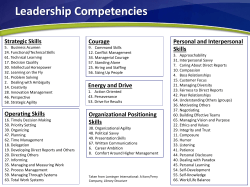
Adult Development_15 04 24.pptx
Adult Development & Complexity CBODN 2015 Conference April 24, 2015 2 Introductions ´ Name ´ What brought you here? 3 Agenda ´ Adult Development: What is it and why should we care? ´ Exercises: Identify developmental stage ´ Assessments 4 Standing on Broad Shoulders… ´ Piaget ´ Loevinger ´ Robert Kegan ´ Susanne Cook-Greuter ´ William Torbert ´ Kurt Fischer ´ Theo Dawson 5 Adult Development What is it, and why should we care? 6 Complexity ´ In your work, what is something you easily do now that you either couldn’t do before, or it was a stretch? 7 Piaget’s Work with Children 8 Capacity for Complexity ´ Ability to perceive complexity of your world ´ Openness to feedback ´ Hold ambiguity and paradox ´ Stand outside of oneself and circumstances ´ Take, seek, and coordinate perspectives ´ See and consider interlocking systems Increases as we develop to later stages 9 Subject-Object Relations When something is “subject” to us: ´ It is part of/fused with us ´ We cannot see it ´ We cannot make decisions about it When something is “object” to us: ´ We can stand outside of it and see/observe it ´ We can make decisions about it 10 Why Is This Important? ´ Our world, organizations, and work has increased in complexity over the last 50 years ´ The majority of the population is at a developmental level that cannot manage this complexity ´ To manage the complexity, leaders must be at a later developmental levels ´ It is incumbent upon organizations to become a Deliberately Developmental Organization (DDO)* *Kegan, R., Lahey, L., Fleming, A., Miller, M., & Markus, I. (April 2014). Making Business Personal. Harvard Business Review. 11 Adult Development Levels Level 3 Category Stages Post-Conventional 6 – Universal principles 5 – Relativity of rules 2 Conventional 4 – Fulfilling duties and upholding laws 3 – Meeting expectations of others 1 Pre-conventional 2 – Getting what you want by trade-off 1 - Punishment avoidance Kohlberg’s Theory of Moral Development 12 Pre-Conventional ´ Typically attained during childhood or adolescence ´ Most adults develop beyond this tier Awareness limited to own perspective 13 Conventional ´ Typically attained in adolescence or young adulthood ´ Most adults develop to these levels, not beyond Awareness of others: “I” à “We” 14 Post-Conventional ´ Fewer than one-fifth of adults attain these stages ´ Transition sometimes coincides with “mid-life crisis” Awareness of “Us” à “All people everywhere” Development Directions 15 Horizonal Vertical Up • • • • • Additive New skills New information More knowledge Apply to other areas • Expanded worldview • Nuanced meaning making • Systems thinking Down/Regression • Life circumstances • Environment • Stress or illness • May be temporary or permanent Nested Stages 16 Early integrative Advanced Systems Advanced Linear Early Systems 17 Advanced Linear Thinking Frequency 60% of population Management Level Entry level (low-tech) Thinking Links ideas in chains of logical relations Reasoning: black and white” Problem Solving Can work successfully with simple workplace problems. Solutions Agility Single solutions: able to suggest a second solution to a complex problem, but it is either unworkable or is viewed as inferior to the first solution Tensions & Polarities Identifies personal and interpersonal tensions in specific situations, sees them as problems to solve Perspective Taking my perspective: likely to make decisions based primarily upon own way of seeing a situation © Lectica. All Rights Reserved. Used with permission. Do not use without permission. 18 Early Systems Thinking Frequency 30% of population Management Level mid-level and entry level (high-tech) Thinking • • Problem Solving Works successfully with complicated workplace problems. Solutions Agility Stronger solutions: • able to suggest a second workable solution to a complex problem • identifies some of its strengths • generally views it as inferior to the first solution Tensions & Polarities Balances tensions: identifies common tensions that arise at different layers in an organizational hierarchy and attempts to balance them Perspective Taking Our perspectives: appreciates that perspectives are limited, likely to invite input from others prior to making a decision One abstract system at a time Reasoning: Shades of gray © Lectica. All Rights Reserved. Used with permission. Do not use without permission. 19 Advanced Systems Thinking Frequency 9% of population Management Level Upper and senior level; top level in small organizations Thinking Can describe multiple abstract systems and identify several of their common elements Problem Solving Can work successfully with complex workplace problems Solutions Agility Multiple acceptable solutions: able to generate multiple viable solutions to a complex problem, and identify their relative strengths and weaknesses Tensions & Polarities Dynamic tensions: identifies several sources of tensions (within and between) llayers in the management hierarchy, and strives to keep them in dynamic balance Perspective Taking Coordinating perspectives: appreciates that all perspectives are limited and fallible, likely to make others part of the decision-making process © Lectica. All Rights Reserved. Used with permission. Do not use without permission. 20 Early Integrative Thinking Frequency <1% of population Management Level Top level (large organizations) Thinking Can describe several abstract systems and identify broad shared principles that govern their interaction. Problem Solving Can work successfully with chaotic workplace problems. Solutions Agility Tensions & Polarities Perspective Taking adaptive solutions: able to facilitate effective and timely response in a changing environment by rapidly generating multiple viable approaches to a wide range of highly complex problems resolves tensions: simplifies the complex by identifying integrative principles that dissolve common tensions/ polarities, and uses these principles to design systems, policies, and structures that optimize outcomes for all stakeholders Appreciates that individuals and groups at all levels in a given system have a shared interest in creating and preserving an optimal institutional culture. © Lectica. All Rights Reserved. Used with permission. Do not use without permission. 21 Stage In Action 22 Scenario © Lectica. All Rights Reserved. Used with permission. Do not use without permission. 23 Exercise: Form a Hypothesis © Lectica. All Rights Reserved. Used with permission. Do not use without permission. 24 Different Names/Similar Theories 25 Words of Caution ´ Later is not better ´ Later is not happier ´ Later only means you can see and manage more complexity ´ Moving whole stages takes years ´ Stage transition is characterized by: ´ A certain amount of disorientation ´ No longer satisfied with what is ´ Things don’t make sense the way they used to ´ Overall “ennui” 26 Assessments 27 Assessments ´ MAP – Loevinger, Cook-Greuter ´ SOI – Kegan, Lahey ´ LAS (LDMA, LSUA) -- Dawson 28 Making Meaning Together.. ´ How are you making meaning of this? ´ What are the implications of this in your work? 29 Further Readings ´ Cook-Greuter, S. (2004). Making the case for a developmental perspective. Industrial and Commercial Training, 36(6/7), 275-281. ´ Garvy-Berger, J. (2012). Changing on the job: Developing leaders for a complex world. Stanford, California: Stanford Business Books, an imprint of Stanford University Press. ´ Joiner, B., & Josephs, S. (2007). Leadership agility: Five levels of mastery for anticipating and initiating change (1st ed.). San Francisco: Jossey-Bass. ´ Kegan, R., Lahey, L., Fleming, A., Miller, M., & Markus, I. (April 2014). Making Business Personal. Harvard Business Review. ´ Kegan, R., & Lahey, L. L. (2009). Immunity to change: How to overcome it and unlock potential in yourself and your organization. Boston, Mass.: Harvard Business Press. ´ Kegan, R. (1994). In over our heads: The mental demands of modern life. Cambridge, MA: Harvard University Press. ´ Rooke, D., & Torbert, W. R. (2005). 7 Transformations of Leadership. Harvard Business Review, 83(4), 66-76. 30 Last Thoughts If we want to increase mental complexity, we need to move aspects of our meaning-making from subject to object, to alter our mindset so that a way of knowing or making meaning becomes a kind of “tool” that we have (and can control or use) rather than something that has us (and therefore controls and uses us.) Kegan & Lahey, Immunity To Change, p. 51 31 Thank you!
© Copyright 2024











